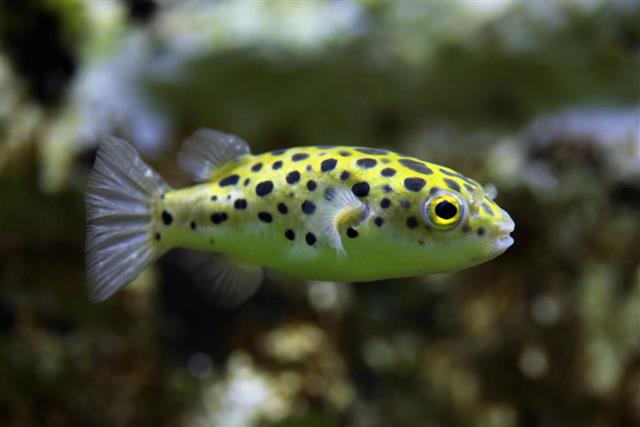
Endemic to a small river in India, the dwarf pufferfish may not be as popular as its cousins in the sea. However, there is no denying the fact that it is pretty interesting in itself.
The river Pamba in Kerala, India, is home to the dwarf pufferfish (Carinotetraodon travancoricus); named so because of the fact that it measures less than an inch in length. In fact, it is one of the smallest pufferfish species in the world. The dwarf pufferfish is often mistaken for the dwarf Malabar pufferfish (Carinotetraodon imitator), not just because of the striking physical resemblance between these two, but also because of the resemblance in their name. The dwarf pufferfish is also known as the Malabar pufferfish. Other names for the species include the pea pufferfish and pygmy pufferfish.
There exist quite a few fascinating things about this species. Its eyes, for instance, are black in color, but turn blue when they are exposed to light. More importantly, its eyes are capable of moving independently of each other―a characteristic trait mostly associated with chameleons. It is common to see the fish opening its mouth wide open, as if it were yawning. A dwarf pufferfish may sometimes curl its tail, which might be an indication that it is somehow uncomfortable or suffering from some illness.
Determining the gender of a dwarf pufferfish is quite a challenge, until it has attained maturity. A matured male will bear a dark line that runs down its yellowish belly. Checking for wrinkles behind the eyes, which is the case in male puffers, is another way of differentiating them from female puffers. Additionally, the body shape of females is generally rounder than that of males.
Tank Size
As it is obvious from the tiny size of this freshwater fish, the tank need not be huge or so spacious. A 10-gallon tank will be more than enough. The fish might become aggressive in response to the presence of another of its kind, when confined to small spaces. So, 5 gallons per puffer is the general recommendation. Male dwarf pufferfish are known to be aggressive towards other males, especially during mating season. There is no dearth of instances wherein two males of this species have fought to death in captivity. So, it is wise that you keep 2 – 3 females for every male. This way, there will be less rivalry and so, fewer fights.
Water
As far as the water is concerned, the dwarf pufferfish has the ability to thrive in almost all kinds of water. However, you must maintain good conditions in the tank to keep your fish healthy and free from any illness. Water with a temperature of around 81 °F and a pH level of at least 7.0 will be ideal for the species. More importantly, you need to ensure that the ammonia and nitrite levels of the water are always at 0.
Food
As for its diet in captivity, pufferfish will eagerly feed on bloodworms, brine shrimp, mysis shrimp, daphnia, tubifex worms, glass worms, and krill. These foods can be given in frozen form as well, but make sure that you thaw them before you put them in the tank. Live foods that are fancied by the fish include blackworms, brine shrimp, and snails. In fact, snails are your best bet when it comes to dwarf pufferfish diet. So, drop a live snail in the tank and have some fun watching your little puffer hunt it down!
At times, you will notice that your pet pufferfish will just not eat anything; no matter what you try to feed it. This is especially the case with the specimen caught in the wild and introduced in the aquarium. For them, prepared foods just do not fit the bill. So, for the first few days, your fish may not be comfortable with the foods you are providing it. Eventually though, it will grow out of its shyness and get used to the food.
Diseases which are commonly diagnosed in this species include ich (a common protozoan disease that is often called ‘white spot disease’), fungal infections, bacterial infections, and internal parasites. Medicines that help in the treatment of these conditions do exist, but before you put them to use, you should consult a veterinarian.








